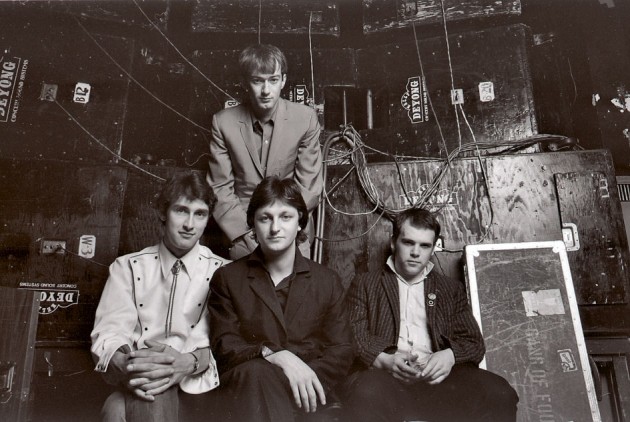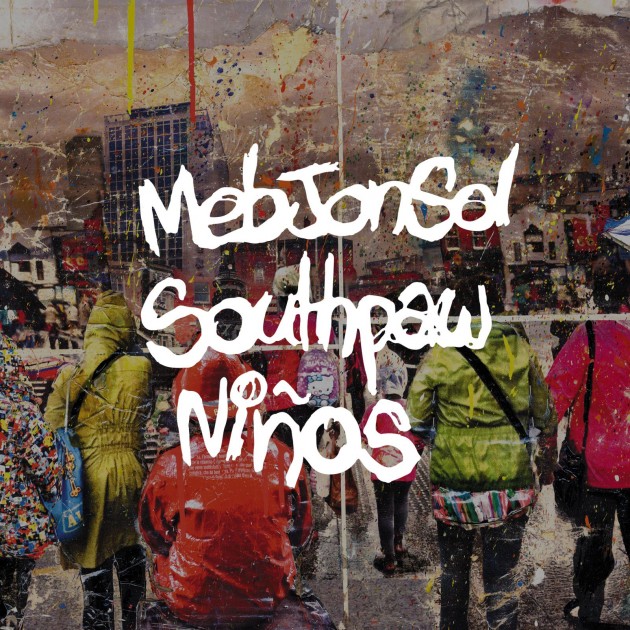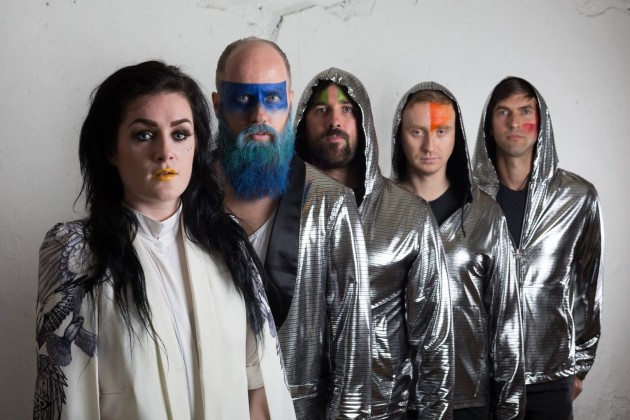Unlike many genres of music susceptible to the prefix ‘post-’, post-punk stems from largely traceable foundations. Just as the first wave of punk rock formed via so-called ‘protopunk’ pioneers in Velvet Underground, The Stooges and MC5, post-punk represented the inevitable manifestation of punk rock’s reaction against itself. In other words, despite what it apparently implies, post-punk did not arrive ‘after’ punk: it formed and co-existed alongside it, mirroring its DIY values whilst looking towards a more rigorous aesthetic of artistic complexity beyond punk’s stripped-back musical revolution.
Whilst not exactly an outright ‘Year Zero’ or some pre-determined period of rebirth at the hands of subcultural consensus, 1977 was, beyond all expectation, an extraordinarily pivotal year for the monumental rise of punk and the simultaneous development of post-punk as a distinguishable offshoot. With Callaghan’s Britain delivering the impossibly groundbreaking Never Mind The Bollocks… and The Clash, thereby cementing punk’s popular emergence viaRamones the year before, three New York-based bands – Television, Talking Heads and Suicide – were already veering from countercultural opinion.
NYC four-piece Television’s debut album, Marquee Moon, was the sound of punk performed with peerless finesse; a cerebral masterstroke tackling existential doom and urban isolation ultimately rooted in the raw anti-idealism of the genre’s booming demographic. With ultra-slick barrenness, Television’s streamlined craft massively reconstituted the terrain laid down by punk’s earliest stalwarts, not least courtesy of Tom Verlaine and Richard Lloyd’s refreshingly lateral guitar-work, which – needless to say – has had incomparable influence ever since. If, at its root, the lure of punk rock lies in an attitude rather than say, a sound or lifestyle – and if that attitude almost always entails some form of rebellion – Television clearly forged the genre’s earliest anti-statement.
Released in the shadow of Bowie, Strummer and the Sex Pistols at the tail-end of 1977, Talking Heads’ debut, Talking Heads ’77 and synth-doom duo Suicide’s self-titled record completed a triad of spearheading post-punk releases from New York-based artists. Whilst the former masterfully melded psychosis with disco, and polyrhythmic experimentation with David Byrne’s restless observational spiel, Suicide captured maniacal dread, fragmented thought and the mass disillusionment of a thoroughly disaffected generation on ‘songs’ such as ‘Frankie Teardrop’, one of the most harrowing musical distillations of post-Vietnam dread. Out of nowhere, it seemed, post-punk was fast emerging as an incidental introversion of punk’s initial manifesto in Ramones’ ‘Blitzkrieg Bop’.
With Pere Ubu’s consummate 1978 debut, The Modern Dance, being recorded at this precise moment in time, London four-piece Wire’s 1977 debut, Pink Flag, stood as a similarly indispensable snapshot of punk’s practically unnoticeable transition into unorthodox territory. Seeping with mysterious, emotional eloquence, not a million miles away from Marquee Moon, this 21 track, 35 minute debut crystallized a sparsely innovative art-rock aesthetic that Colin Newman and co. perfected on 1978’s Chairs Missing and 1979’s 154, two clinical masterpieces seeping with speckled elements of prog, psychedelia and art-rock. A distinctly English riposte to U.S. post-punk’s dabbling in disco, dub reggae and Krautrock, the significance of Wire’s first three records cannot be understated in the rapid and unpredictable re-alignment of punk in the late ‘70s; they remain hugely important, boundlessly enduring and without precedent.
After leaving a self-imploding Sex Pistols in early 1978, Johnny Rotten, reverting back to his birth name of John Lydon, picked himself up from being snubbed as a potential candidate for the new singer of Devo – themselves having just released their own post-punk statement via Q: Are We Not Men? A: We Are Devo! – and formed Public Image Ltd. Whether he cared for it or not, in joining former school friend Jah Wobble and early Clash member, Keith Levene, to fashion PiL’s abrasive and bass-heavy style of subversive punk, Lydon became a recognisable baton-carrier for punk’s conversion into a new dawn of self-criticism. Although punk had far from ended, the demise of the Sex Pistols – and Sid Vicious’s death in February 1979 – signalled a complex regeneration of its simple foundations.
Two English debut albums recorded in spring 1979, marked post-punk’s self-evident ‘arrival’ proper: Gang Of Four’s (pictured) Entertainment! and Joy Division’s Unknown Pleasures. With its idiosyncratic hybrid of punk, funk and dub, Gang Of Four’s debut effortlessly harnessed frontman Jon King’s grasp of political and social ills to underpin a jagged pop approach that saw post-punk enter a sudden era of quasi-accessibility. With PiL’s legendary Metal Box a mere two months from release, Paul Morley deemed the former’s sound as “demented funk”, a term equally applicable to many of post-punk’s earliest pioneers in The Pop Group, Talking Heads and Pere Ubu. Equally, Unknown Pleasures (not to mention 1980’s Closer) saw Factory four-piece Joy Division amend Suicide’s claustrophobic ruin and Television’s dense austerity with a plodding, unmistakably English approach that culminated in real-life tragedy in 1980.
With growing focus being placed on dub, reggae and funk inspired bass-playing – take, for instance, PiL’s Jah Wobble, Talking Heads’ Tina Weymouth and The Fall’s Marc Riley – post-punk distanced itself from mere three-chord abandonment in favour of bullish experimentation and strategic repetition. Mirroring progressive groundwork laid by Germany’s finest in Can, Kraftwerk and Neu! – not to mention ex-Buzzcock Howard Devoto’s Magazine’s debut, the new wave-centric Real Life – 1979 saw key post-punk releases from The Fall (Live At The Witch Trials and Dragnet) and Bristol four-piece The Pop Group’s thoroughly radical Y; the former courtesy of eerie guitar lines, Mark E. Smith’s eccentric monologues and a general air of menace; the latter at the hands of an impenetrable, jungle-thick density reminiscent of American avant-garde group The Residents and Pere Ubu’s extraordinary 1978 second album, Dub Housing.
The rapid rate of post-punk acts forming from the dense popularity of ‘mere’ punk saw more and more acts being snapped up by shrewd label executives. As a case in point, Essential Logic – formed by saxophonist Lora Logic after leaving X-Ray Spex – released their first 7″ in 1978 on their own record label, Cells. A year later, they released their self-titled EP on Virgin Records before signing up to Geoff Travis’ brand new Rough Trade Records. They are a perfect paradigm that, despite their limited productivity, the advent of the likes of Rough Trade and coverage via John Peel et al underlined post-punk’s growing autonomy in the public consciousness, whilst concurrently splintering into the likes of industrial rock, gothic rock and new wave/no wave on both sides of the Atlantic.
Of course, the would-be ‘purpose’ of post-punk wasn’t exclusively concerned with documenting darkness and despair: while all-female punk group The Slits (previously The Raincoats) disseminated increasingly outdated preconceptions with their brilliantly bobbing, yet no less lyrically severe, ’79 debut, Cut, Andy Partridge’s XTC leapfrogged their own self-created neurosis on White Music via 1979′s melodically kaleidoscopic Drums And Wire and the perfect post-punk-pop of 1980’s Black Sea. Equally, despite receiving much less exposure than some of the aforementioned acts, the quirky, brilliantly retrogressive post-punk of London three-piece The Monochrome Set saw hugely infectious jocularity on albums such as Strange Boutique and Love Zombies, whilst Edwin Collins’ Orange Juice represented a carefree take on post-punk without fully abandoning the genre’s progressive mentality. Each of these acts stands as a reminder that the development of post-punk was neither circumscribed nor completely nihilistic.
That said, by the mid-Eighties, gothic rock and industrial rock began to sprout from the gaps within punk in all its forms. With Crawley four-piece The Cure’s early career taking in the sparse desolation of their 1979 debut, Three Imaginary Boys, right through to their most uncompromisingly gothic release, 1982′s Pornography and, three years later, the positively effervescent Head On the Door, Siouxsie and the Banshees – actually the first band to be called “post-punk” by the press in 1977 – spearheaded their own experimental brand of post-punk/avant-garde music on late Seventies releases The Scream and Join Hands. Taking in abrasive noise, gothic and straight-up post-punk, the mid-to-late Eighties saw the continued (not to mention hugely rewarding) deformation of punk rock.
With the significantly more marketable new wave setting off on its own path via Blondie, The Cars and the evolving Talking Heads, bands including Mission Of Burma (Vs.), R.E.M. (Murmur) and New York no wave band Sonic Youth (Confusion Is Sex/Kill Yr. Idols) summoned a new generation of alternative/college rock diversely representing post-punk’s continued evolution from the punk rock’s first wave circa 1974-1978. Even today, 35 years on from Television, Talking Heads and Suicide’s early rumblings of punk experimentation, a never-ending ‘post-punk revival’ courtesy of Interpol, The Strokes, Franz Ferdinand and literally countless acts in between has seen perhaps the genre’s most critically and commercially successful period ever.
Stream an accompanying Post-Punk Spotify playlist below.






